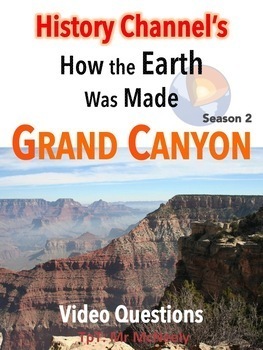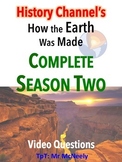History Channel's How the Earth Was Made: Grand Canyon Video Questions Worksheet
- Zip
What educators are saying
Also included in
- How the Earth Was Made Season 2 is a wonderful 13-episode earth science documentary series that was originally broadcast on the History Channel. The episodes are set up as detective stories, where multiple lines of evidence are used to come to reasonable conclusions. You will need to obtain DVDs ofPrice $19.00Original Price $26.00Save $7.00
Description
History Channel's How the Earth Was Made is a wonderful earth science documentary series. The episode titled "Grand Canyon" is the story of the discovery of the geologic forces that created the iconic natural wonder. The episode is set up as a type of detective story, with evidence shown to back up a hypothesis. You will need to obtain a DVD of the episode, or locate an internet site for streaming.
The video worksheet is a one-page, double-sided handout consisting of 49 multiple choice questions that track the progress of the video. This format enables the students to pay attention to the video while quickly recording their answers. In this way, the students are not bogged down in writing long responses, and they can better enjoy watching the video. A key is included, and the files are provided in both MS Word and PDF formats.
Other Resources:
A Google Forms, self-grading quiz of the video questions is available here. (Note: Access to the Google Forms quiz requires an extra charge.)
A Google Doc version of the video worksheet is available here. (Note: Access to the Google Doc requires an extra charge.)
The video is available for streaming on the History Channel official YouTube site. (Please make sure that the video is accessible before purchasing this TPT resource.)
Overview: How the Earth Was Made: Grand Canyon
One of geology’s greatest mysteries is explaining how the Colorado River formed the Grand Canyon. The canyon presents a unique sequence of ancient, Precambrian schist at bottom, topped by a layer cake of much younger Paleozoic and Mesozoic sedimentary rocks formed mainly by ancient, inland seas. The first scientific study of the canyon was the expedition of John Wesley Powell, the first scientist to travel the length of the canyon by boat. He first described the “ugly black rocks” at the canyon’s bottom, today called the Vishnu Schist. Schist is a metamorphic rock that forms under heat and pressure. Radioactive analysis of the rocks returns an age of 1.7 billion years. According to an analysis of the calcium content of garnets in the rock, the rocks formed at a depth of six miles beneath the Earth’s surface. This implies that a colossal mountain range once stood in this region. Over millions of years, the relentless forces of erosion weathered down the mountains into a flat plane.
Lying atop the Vishnu Schist and other basement rocks of the canyon is a wondrous assembly of flat-lying, sedimentary rocks such as sandstone, shale, and limestone—forming a layer cake of earth history. The fossils of marine organisms in these rocks indicate the presence of inland seas, which deposited the layers we see today. Beginning around 550 million years ago, the varied rock types indicate that the area had been submerged least eight times. The iron content of these rocks resulted in the rusty red color of many of the rock layers, forming the iconic red-layered appearance of the canyon that we see today.
Since the 1960s, geologists realized that collisions between the plates forming Earth’s crust could force land high up into the air forming a set of folded mountains (See How the Earth Was Made: The Alps Video Questions). Around 70-80 million years ago, a major event termed the Laramide Orogeny dramatically affected the western United States. The entire region that now contains the Grand Canyon was lifted en masse, and it was able to maintain its relatively horizontal orientation. This event created the Colorado Plateau, and established the milieu in which dramatic canyon formation could occur.
The video next documents how scientists were able to date the formation of the Grand Canyon. Earlier ideas had maintained that an offshoot of the Colorado River, the Hindu Canyon, was the catalyst for the Canyon’s formation at an age around 50 million years. An investigation by Dr. Richard Young in 1969 demonstrated that the sediments in Hindu Canyon were oriented in the wrong direction, which was evidence that it was not involved in the formation of the Grand Canyon.
Investigations at Muddy Creek, once the site of a vast freshwater lake, indicate that sediments infiltrated the pristine lake environment around 5.5 million years ago. This is seen as the starting point for the formation of the canyon, and the sediments likely represent the original weathered sediments from the canyon’s development.
Still a geologic mystery, the sequence of events that led to dramatic canyon cutting erosion is investigated next in the video. Some geologists had proposed that several ancient rivers merged to create a vigorous Colorado River. Others suggested that the entire plateau had been forced upward as the Colorado River cut downward, exacerbating its cutting power. These early theories had not been supported by much evidence. According to the newer “spillover” theory published in 2,000 by John Douglass, an immense lake had formed adjacent to the canyon’s current location. Eventually reaching the capacity provided by the underlying basin, the lake had spilled over as an immense outpouring of water, which had had enough force to rapidly cut into the canyon’s sedimentary rock layers. According to Douglass, dried-up Lake Bidahochi had the correct depth and size to initiate such a titanic release of water. Deep-water fossils identified in lake sediments also helped to establish the lake at 6 million years, which is the correct age for canyon formation. The video also documents a scale-model experiment that Douglass performed at his college campus in Phoenix, where tons of soil was placed in an enclosure, and an artificial lake created on one side. Eventually, as the lake filled, it cut through a wall of soil and created a dramatic “canyon”.
Work to determine the rate of canyon cutting is demonstrated in the video by sand samples taken at Lee’s Ferry by professor Joel Pederson. These deposits have remained buried for the past few million years, where sand grains derive an excess of electrons from exposure to radioactive elements. The greater the length of burial, the greater the amount of excess energy stored in the grains. The amount of energy released by the grains under laboratory conditions can then be used to determine how long the sediments had been buried. Exposure to sunlight resets this internal clock. Such luminescence measurements reveal an erosion rate of 1,000 feet per million years, or about 1 foot per thousand years. Given this result, the entire 5,300 foot deep Grand Canyon could have been cut in just under 5 million years.
Water on its own has little erosive power. When it carries sand and boulders, the myriad collisions between rock particles creates a greater force to break down the canyon rocks. Every day, the Colorado River carries about 500,000 tons of rock and debris—enough to fill 100 Olympic-sized swimming pools.
The hundreds of rapids in the river also increase water’s erosive power. Flash floods carry boulders into the river, and these barriers cause water to increase its energy and cut deeper into the downstream rocks. Gravity and simple physics can explain how the river was able to carve so much rock, so quickly. For every mile that it travels, the Colorado River falls by 10 feet. The steep slope also helps to drive the erosive potential of the river water.
Explaining the extreme width of the canyon can be problematic. For example, at the South Rim the Grand Canyon extends a distance of 18 miles across. One factor contributing to the width of the canyon is the interplay of hard and soft sedimentary rock layers. Soft rock layers such as shale can erode faster, which creates undercutting and rapid falling of harder overlying rocks such as limestone or sandstone. These rocks all fall sway to the natural erosive force of wind, water, and ice. The eroded debris is then carried away by the Colorado River, which enables the canyon to remain relatively empty of debris, and further enabling the erosive forces attacking the sides of the canyon.
Volcanic activity has also affected the Grand Canyon. Less than one million years ago, an assembly of cinder cone volcanoes formed in a remote section of the canyon named Toroweap Point. Lava flows, still visible as black deposits on the side of the canyon, had occasionally dammed the river. John Wesley Powell had first observed these ancient flows, and remarked eloquently upon what a spectacular sight that must have been. Today, the volcanic cones appear to be extinct and lifeless, although there is some speculation otherwise. The last eruption was about one thousand years ago.






